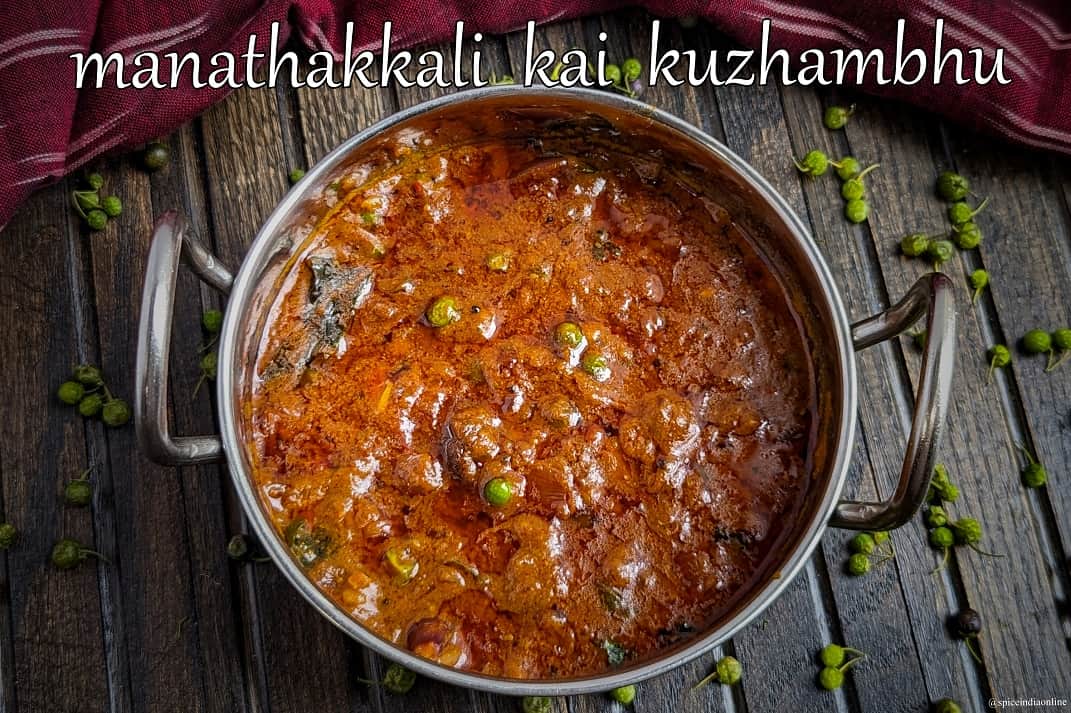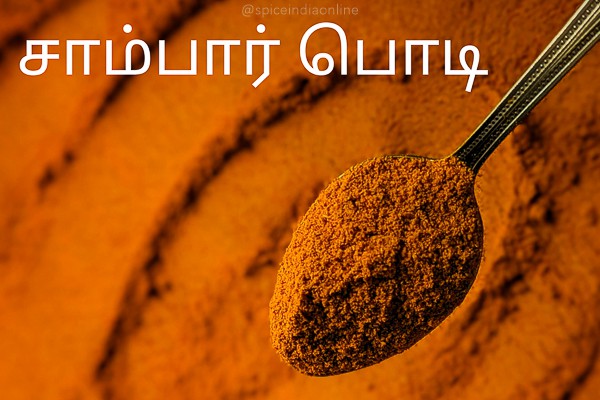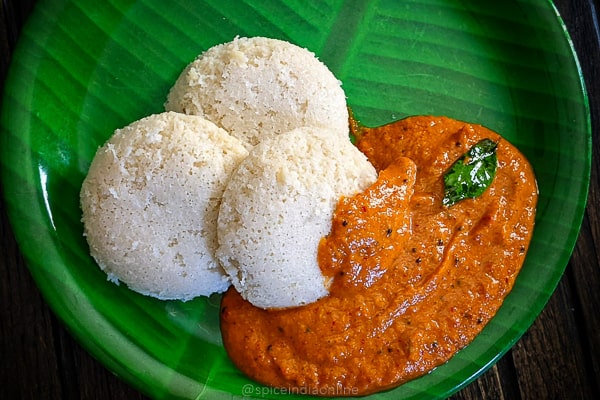Description:
Puliyodharai is a South Indian rice preparation, a mainstay in most Indian festival luncheons and dinners. It is also offered as prasadams in temples. Prasadam (a Sanskrit word) is food that has first been offered to God prepared by the temple priests in the temple Madapalli (Temple kitchen). Thiru madapalli is traditionally the kitchen in Vaishnavite temples, apart from catering to the divine Lord, these kitchens often serve Prasadams to the devotees. Madapalli’s are famous for Ven pongal , Puliyodharai, Sarkarai Pongal, Vadai, Laddu, Thayir sadam & Sambar sadam. These are distributed to devotees in either fresh banana leaves or dry banana leaf cups (Thonnai). My favorite is Perumal Kovil madapalli prasadams, especially their Puliyodharai are very famous for tongue tickling taste! No matter how hard we try, we can never replicate that divine taste in our home kitchens but always wanted to try something which is atleast close to that taste. There are a million versions online but I personally liked the one shared by Mrs. Jayashree Govindarajan in her lovely blog My kithcenpitch. She has shared an interesting Temple Style Puliyodharai, it looked very authentic and I got instantly hooked! I tried her version as it is but added puliyodharai powder to the pulikachal mix, it turned out great and matched the temple style puliyodharai. Here goes the recipe….
Puliyodharai Recipe / Temple Style Puliyodharai Recipe / Puli Sadam / Kovil Puli Sadam / Kovil Puliyodharai / Temple Pulihora /Puli Sadam Mix / Puliyodharai Mix / Puliyodharai Paste Recipes / Rice Recipes / How to make Puliyodharai ? / Koil Puli Sadam / Kovil Puliyodharai / How to make Pulikachal / Puli Sadam Mix / Puliyodharai Powder Recipe / Temple Puliyodharai / கோயில் புளியோதரை
| Puliyodharai Powder (Roast and grind) | |
|---|---|
| Dry Red Chilli | 2 (long) |
| Channa dal / Kadalai paruppu | 2 Tablespoons |
| Black gram / Ulutham paruppu | 1 Tablespoon |
| Black peppercorn | 1 teaspoon |
| Fenugreek seeds | 1/2 teaspoon |
| Cumin seeds | 1/2 teaspoon |
| Oil | 1/2 teaspoon |
| Pulikachal | |
|---|---|
| Tamarind | 2 Gooseberry size (Extract pulp with 1 cup water ) |
| Sesame oil / Nallennai | 2 Tablespoons |
| Mustard seeds | 1 teaspoons |
| Cumin seeds | 1/2 teaspoon |
| Dry Red Chilli | 2 Long |
| Channa dal / Kadala paruppu | 1 teaspoons |
| Black gram / Ulutham paruppu | 1/2 teaspoon |
| Fenugreek seeds | 1/4 teaspoon |
| Asafoetida | 1/4 teaspoon |
| Curry leaves | few |
| Roasted Peanuts | 2 Tablespoons |
| Turmeric powder | 1/2 teaspoon |
| Salt | 1 teaspoon |
| Oil | 2 Tablespoons |
| Additional ingredients | |
|---|---|
| Cooked Rice | 4 cups ( 1 cup of raw rice roughly yields about 2 1/2 – 3 cups of cooked rice) |
| Sesame oil | 5 Tablespoons |
| Salt | 1 teaspoon |
| Black peppercorns | 4 Teaspoons |
Method:
This recipe basically revolves around 3 important items. Tamarind extract, Puliyodharai powder and Freshly ground black pepper powder.
Lets proceed…
1. Tamarind Extract:
Soak tamarind in 1 cup water for 30 minutes. Mash the soften tamarind in water until the fiber separates. Squeeze and extract the pulp and throw the waste. Keep this thick pulp aside.
2. Puliyodharai Powder:
This powder is not always required but adding this really makes a difference in taste. Heat oil in a pan and start roasting the dry red chili, channa dal, urad dal, black pepper, cumin and fenugreek on low flame.
Roast until the aroma comes or till they turn golden which usually takes 10-12 minutes. Take care not to burn the spices, roast over very low flame. Once done, let cool completely and grind to a fine powder.
3. Freshly ground Black pepper powder:
Grind 4 teaspoons of black peppercorns to fine powder consistency and keep aside. (Original recipe by Mrs Jayanthi Govindarajan does not include any dry red chilis, coriander seeds nor sesame seeds and is made with plain freshly ground black pepper powder alone) Adding this fresh pepper powder is the highlight, do not skip. It gives a unique taste to this puliyodharai.
How to make the Pulikachal: (Use ingredients from Table-2)
Heat oil in a pan and splutter mustard seeds, the add channa dal and split black gram dal and roast them till red or golden followed by cumin seeds, dry red chili , roasted peanuts and curry leaves. Let them roast for few seconds then add turmeric, asafoetida and salt.
Now add the tamarind extract and cook over low flame until the raw tamarind smell disappears. This usually take about 15 minutes over low flame.
When the extract condenses to a thick runny consistency, the oil will separate.
Add a teaspoon of the puliyodharai powder at this stage, it will instantly thicken the gravy.
Switch off and remove from heat.
Pulikachal is ready for use.
Take cooked rice rice in wide bowl, drizzle sesame oil on it, add about 3/4 of the pulikachal, one teaspoon of the black pepper powder, one teaspoon of the Puliyodharai powder and one teaspoon of salt. Gently mix to combine, take care not to make the rice too mushy.
Check salt and spice level, the pulikachal already has salt plus we are adding some now which should be sufficient for the amount of rice given but adjust according to your taste. For a spicer version add more black pepper powder. Once done with mixing, cover and let it sit for atleast an hour, this way the rice will absorb all the flavor from the mix and makes your Puliyodharai taste even better.
Serve plain or with pappad.
Notes |
| Yields about 4 cups of puliyodharai, 3 Adult servings. |
| Both Pulikachal and puliyodharai powder keeps well for couple of weeks if refrigerated. |
| 1/4 of the pulikachal was left out intentionally. Add it if you want your rice to taste more tangy. |
| This recipe does not inlcude jaggery, you may add a 1/4 teaspoon while making pulikachal if you prefer lightly sweet and tangy. |
| This recipe is made with Pachai arisi ( Normal Raw rice)(Recommended), you may also try with Basmati rice. |
| Roasted peanuts are used for this recipe, if using raw peanuts.. then dry roast them in a tawa and then proceed. |
| Puliyodharai powder is optional too, you may try without the powder too but increase the black pepper powder. |
| I’ve used vellai puli for this recipe, use of dark tamarind (Karuppu Puli) will yield a darker color Puliyodhari. |



















14 Comments
Where to get good quality thonai of healthy leaves not rotten leaves with no plastic, cardboard, or cloth fillers?
You can get fresh leaves only in India, I brought mine from there and some Indian stores in USA have them but not sure exactly where. Just call and request if they can order for you.
Thanks!
I tried this today and everyone in my house loved it. My husband said it tastes like kovil puliyidharai. Thanks for the recipe. It’s going to be my go to recipe for puliyodharai. The best part is the powder which I can store in the fridge and quickly make the puliyidharai whenever I want.
So happy to hear Chandrika, yep that powder is a life saver for weekday lunch box packing… it will be done in minutes, that pepper powder also plays a good role in it. Glad you all enjoyed and thanks a million for writing a feedback. Happy cooking!
Hi, I am wondering what kind of sesame oil you used? is it just 100% pure, or the toasted/roasted sesame oil?
Elia,
I’ve used Idhayam Sesame oil which is mild flavor sesame oil, will work great for this recipe. Toasted sesame oil is very strong in flavor and if using that you got to add very little. I’m not sure whether these are 100 % pure but would luv to know if something like that exist! Thanks.
Hi Mullai,
I tried ur recipe.it was awesome.supposing if I use double
Quantity of rice should increase the other ingredients measure also?if
So then in what proportions?
Yummy recipe….its an absolute all time fav recipe of mine but am always scared to try thinking what if it doesn’t taste the same as mom makes…ur recipe has given ,e confidence to atleast make an attempt and taste great (hopefully)
Thanks for sharing
Kavi
Kavitha, it well turn out good, there’s always room for adjustment in this recipe. Reserve some cooked rice and Puli gravy, so that you can adjust later. Make sure you use the regular tamarind instead of the ready made puli paste. Let me how it turned out, thanks and goodluck!
Mullai
Wow, mouthwatering pics and yummy recipe. Btw where did u get the thonai in US.
Thanks Rekha, those thonnai cups are from India… never seen them here in US.
Chanceee illa. Yummy puliodarai. Thanks for sharing. Will try this weekend.
Thanks Radhi, illana enga veetukum varalam!
I want to go back to Parthasarathy temple’s and eat their puliyodharai or I might just make yours at home.